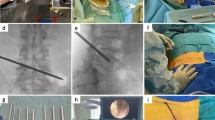Abstract
Recently, the presence of a high-intensity zone (HIZ) within the posterior annulus seen on T2-weighted MRI has aroused great interest and even controversy among many investigators, particularly on whether the HIZ was closely associated with a concordant pain response on awake discography. The study attempted to interpret the correlation between the presence of the HIZ on MRI and awake discography, as well as its characteristic pathology. Fifty two patients with low back pain without disc herniation underwent MRI and discography successively. Each disc with HIZ was correlated for an association between the presence of a HIZ and the grading of annular disruption and a concordant pain response. Eleven specimens of lumbar intervertebral discs which contain HIZ in the posterior annulus from 11 patients with discogenic low back pain were harvested for histologic examination to interpret the histologic basis of a nociceptive response during posterior lumbar interbody fusion (PLIF). The study found that in all of 142 discograms in 52 patients, 17 presented HIZ. All 17 discs with HIZ showed painful reproduction and abnormal morphology with annular tears extending either well into or through the outer third of the annulus fibrosus. The consecutive sagittal slices through the HIZ lesion showed that a notable histologic feature of the formation of vascularized granulation tissue in the outer region of the annulus fibrosus. The current study suggests that the HIZ of the lumbar disc on MRI in the patient with low back pain could be considered as a reliable marker of painful outer anular disruption.



Similar content being viewed by others
References
Aprill C, Bogduk N (1992) High-intensity zone: A diagnostic sign of painful lumbar disc on magnetic resonance imaging. Br J Radiol 65:361–369
Bogduk N(1998) Point of view. Spine 23:1259–1260
Burke JG, Watson RWG, McCormack D et al (2002) Intervertebral discs which cause low back pain secrete high levels of proinflammatory mediators. J Bone Joint Surg (Br) 84:196–201
Carragee E, Paragioudakis SJ, Khurana S (2000) Lumbar high-intensity zone and discography in subjects without low back problems. Spine 25:2987–2992
Coppes MH, Marani E, Thomeer RTWM, Groen GJ (1997) Innervation of “ painful ”lumbar discs. Spine 22:2342–2350
Coppes MH, Marani E, Thomeer RTWM, Oudega M, Groen GJ (1990) Innervation of annulus fibrosis in low back pain. Lancet 336:189–190
Freemont AJ, Peacock TE, Goupile P, Hoyland JA, O’Brien J, Jayson MIV (1997) Nerve ingrowth into diseased intervertebral disc in chronic back pain. Lancet 350:178–181
Ito M, Incorvaia KM, Yu SF et al (1998) Predictive sins of discogenic lumbar pain on magnetic resonance imaging with discography correlation. Spine 23:1252–1260
Lam KS, Carlin D, Mulholland RC (2000) Lumbar disc high-intensity zone: the value and significance of provocative discography in the determination of the discogenic pain source. Eur Spine J 9:36–41
Peng B, Wu W, Hou X, Li P, Zhang C, Yang Y (2004) The pathogenesis of discogenic low back pain. Combined meeting of leading scientific spine societies. Porto, Portugal, 536
Rankine JJ, Gill KP, Huthcinson CE, Ross ERS, Williamson JB (1999) The clinical significance of the high-intensity zone on lumbar spine magnetic resonance imaging. Spine 24:1913–1920
Rickeson R, Simmons JW, Hauser BO (1996) The, prolapsed intervertebral disc: The high-intensity zone with discography correlation. Spine 21:2758–2762
Ross JS, Modic MT, Masaryk TJ (1990) Tears of the annulus fibrosus: Assessment with Gd-DTPA-enhanced MR imaging. Am J Roentgenol 154:159–162
Sachs BL, Vanharanta H, Spivey MA et al (1987) Dallas discogram description: A new classification of CT/discography in low back disorders. Spine 12:287–294
Saifuddin A, Braithwaite I, White J, Taylor BA, Renton P (1998) The value of lumbar spine magnetic resonance imaging in the demonstration of anular tears. Spine 23:453–437
Schellhas KP, Pollei SR, Gundry CR, Heithoff KB (1996) Lumbar disc high-intensity zone: Corrrelation of magnetic resonance imaging and discography. Spine 21:79–86
Tsuji H, Hirano N, Ohshima H, Terahata N, Motoe T (1993) Structural variation of the anterior and posterior annulus fibrosus in the development of human lumbar intervertebral disc: A risk factor for intervertebral disc rupture. Spine 18:204–210
Yasuma T, Arai K, Yamauchi Y (1993) The histology of lumbar intervertebral disc herniation: The significance of small blood vessels in the extruded tissue. Spine 18:1761–1765
Yu S, Haughton VM, Setter LA, Wagner M (1989) Comparison of MR and discography in detecting radial tears of the annulus: A postmortem study. Am J Neuroradiol 110:1077–1081
Author information
Authors and Affiliations
Corresponding author
Additional information
Supported by a grant for scientific research of great project of clinical new technique from 304th Hospital (to Dr. Peng)
Rights and permissions
About this article
Cite this article
Peng, B., Hou, S., Wu, W. et al. The pathogenesis and clinical significance of a high-intensity zone (HIZ) of lumbar intervertebral disc on MR imaging in the patient with discogenic low back pain. Eur Spine J 15, 583–587 (2006). https://doi.org/10.1007/s00586-005-0892-8
Received:
Revised:
Accepted:
Published:
Issue Date:
DOI: https://doi.org/10.1007/s00586-005-0892-8




